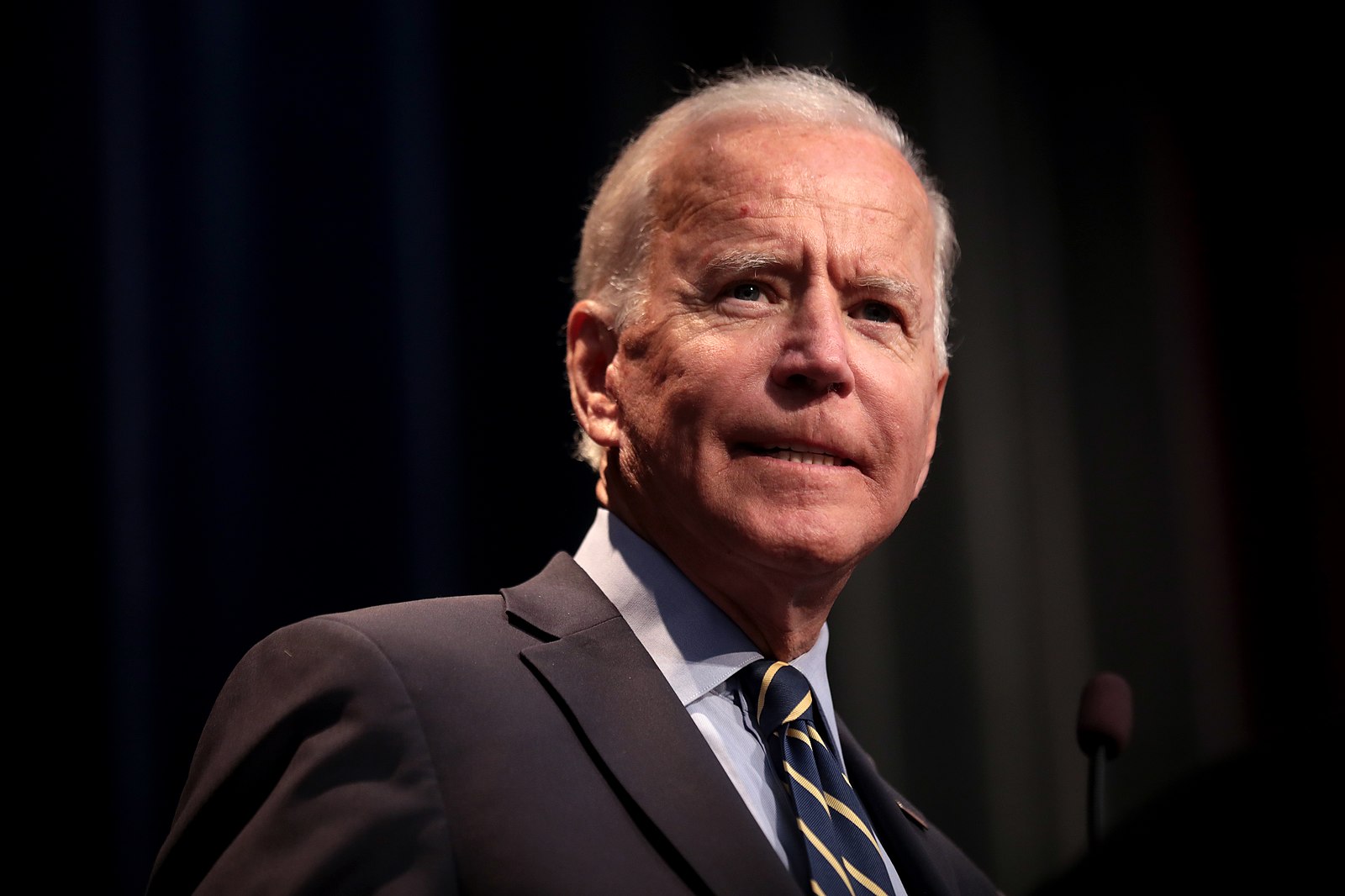Biden Administration Introduces FLOW to Improve Supply Chain – Exciting as a Visit from Aunt Flo
On Tuesday (March 15th, 2022), the Biden Administration put out a “fact sheet” in announcing a freight data exchange program with the intention of improving the still badly congested supply chain. The information exchange is dubbed Freight Logistics Optimization Works or FLOW. Ah, I see what you did there, White House: it’s called wishful thinking.
FLOW obviously won’t be any kind of immediate fix to get the supply chain flowing, but more transparency in the supply chain is certainly a good thing. And who better to lead the way than the incredibly transparent Biden Administration? Even if a simple lack of transparency was the biggest or one of the biggest causes of the “supply chain crisis” we’ve been facing, which it’s not, it won’t be until the end of summer that the White House expects to even have a proof-of-concept.

When I say more transparency in the supply chain would be a good thing, I particularly mean on the part of ocean freight carriers. Carriers notoriously lack transparency in their operations. It’s been a problem in the international shipping industry since long before I started writing about it over a decade ago, during which time I have made mention of carriers’ transparency issue several times in Universal Cargo’s blog.
The Actual Cause of the Supply Chain Crisis
While a lack of transparency on the part of carriers does add to their unreliability, which is something they are also notorious for, it is not one of the biggest factors in the major supply chain problems we’ve been experiencing for the last two years and that has gotten much worse over the last year. Repeatedly, I’ve gotten into the major causes of the supply chain disruption we’ve been experiencing, but let’s do it one more time for the Biden Administration, sitting in the back of the room.
Policy-Driven Demand Boom
The “supply chain crisis” was triggered by lockdowns and government stimuli creating a boom in consumer spending on goods that caused, in turn, shipping demand to boom with month after month after month after month of near-record to record-high volume hitting the ports. But there were years of other factors building up to make the demand increase such a problem.
Much-Reduced Carrier Competition
One factor was carriers consolidating into just three carrier alliances, which allowed them to manipulate capacity (supply), which they shrunk below market demand through hundreds of blanked (cancelled) sailings at the beginning of the pandemic when demand was expected to decrease. This caused shipping containers and equipment to be maldistributed around the world when demand boomed. These carrier alliances are all approved by federal regulators – something I’ve been calling out as a problem for years in this blog.
Unions Against Automation
Another factor is that the powerful dockworker unions have fought against automation at US ports for years. The result is ports in the US that are less efficient than their counterports (hey White House, I can play with words too) around the world. Who thought this would ever be a problem in the face of more and more goods being shipped every year? Oh, everyone? Everyone who knew about it thought it was problem?
Additional Factors
Additional factors creating the “supply chain crisis” are Covid restrictions and even closures at ports (further reducing efficiency and productivity) and other supply chain points and a trucker shortage that’s been an issue for years and was exacerbated by vaccine mandates. If you go really far down on the list, you’d eventually probably get to a lack of transparency in the industry contributing to the inefficiency of the supply chain.
Enter Flow
Luckily, we have FLOW to the rescue, where the Department of Transportation (DOT), headed by the incredibly experienced Pete Buttigieg, will lead the information exchange efforts. The White House’s “fact sheet” says, “DOT will lead this effort, playing the role of an honest broker and convener to bring supply chain stakeholders together to problem solve and overcome coordination challenges.”
Part of the Biden Administration being an honest anything certainly sounds like “playing a role” to me. But I certainly do hope FLOW is successful in creating more transparency and efficiency in the supply chain and doesn’t evolve into unnecessary regulations requiring compliance on players within the shipping industry that ends up causing even more inefficiency in the supply chain.
One thing I do like is that, of the 18 partners playing a leadership role in shaping this data exchange, there are two major ocean freight carriers recruited: CMA CGM and MSC. As stated above, ocean freight carriers lack transparency. Of course, if they’re shaping what information is shared, shippers may not see improvements in transparency where they’d like to see it with carriers. We’ll have to watch and see how it turns out.
Full Text of Biden Administration’s Announcement of FLOW
Here’s the full text of the White House’s “fact sheet” on FLOW:
Fact Sheet: Biden-Harris Administration Announces New Initiative to Improve Supply Chain Data Flow
March 15, 2022 • Statements and Releases
Freight Logistics Optimization Works (FLOW) Will Speed Up Delivery Times and Reduce Consumer Costs
White House to Host Launch Event Today with Key Industry Stakeholders
Since taking office, the Biden-Harris Administration has been focused on addressing supply chain vulnerabilities and congestion, working to speed up the movement of goods, and lower costs for families. Last year, the ports and the private sector moved a historic amount of goods with record holiday sales and delivery times below pre-pandemic levels. Currently, real retail inventories excluding autos are six percent higher than at the end of 2019 and products at grocery and drug stores are 90 percent in stock, just 1 percentage point below pre-pandemic levels.
The Administration is also focused on addressing the longer-term weaknesses in our nation’s supply chains, the result of decades of underinvestment, outsourcing, and offshoring instead of investment in long-term security, sustainability, and resilience. The Bipartisan Infrastructure Law (BIL) is now making a generational investment in our ports, highways, and other parts of our physical infrastructure, which will help speed up the movement of goods and lower costs. But we can further strengthen our goods movement supply chains by making a similarly bold improvement in a digital infrastructure to connect the supply chain.
To take the first step toward addressing this challenge, the Biden-Harris Administration is announcing the launch of Freight Logistics Optimization Works (FLOW), an information sharing initiative to pilot key freight information exchange between parts of the goods movement supply chain. FLOW includes eighteen initial participants that represent diverse perspectives across the supply chain, including private businesses, warehousing, and logistics companies, ports, and more. These key stakeholders will work together with the Administration to develop a proof-of-concept information exchange to ease supply chain congestion, speed up the movement of goods, and ultimately cut costs for American consumers. DOT will lead this effort, playing the role of an honest broker and convener to bring supply chain stakeholders together to problem solve and overcome coordination challenges. This initial phase aims to produce a proof-of-concept freight information exchange by the end of the summer.
A Novel Data Sharing Partnership
Recent supply chain disruptions have raised national awareness of the need for improved information exchange. Supply chain stakeholders deserve reliable, predictable, and accurate information about goods movement and FLOW will test the idea that cooperation on foundational freight digital infrastructure is in the interest of both public and private parties. FLOW is designed to support businesses throughout the supply chain and improve accuracy of information from end-to-end for a more resilient supply chain.
Resiliency—the ability to recover from an unexpected shock—requires visibility, agility, and redundancy. The lack of digital infrastructure and transparency makes our supply chains brittle and unable to adapt when faced with a shock. The goods movement chain is almost entirely privately operated and spans shipping lines, ports, terminal operators, truckers, railroads, warehouses, and cargo owners such as retailers. These different actors have made great strides in digitizing their own internal operations, but they do not always exchange information with each other. This lack of information exchange can cause delays as cargo moves from one part of the supply chain to another, driving up costs and increasing goods movement fragility.
This effort shows a strong and deliberate response by the Administration to tackle this challenge head-on and set the country on the right trajectory for a resilient and globally competitive 21st century goods movement chain. The Biden-Harris Administration is laser focused and creative in identifying ways to speed up the movement of goods from ships to shelves and cut costs for American consumers. With FLOW, the Biden Administration will play a leadership role in bringing companies together to problem solve for the American people. Initial partners in FLOW include:
Port Authorities:
- Port of Long Beach
- Port of Los Angeles
- Georgia Ports Authority
Ocean Carriers:
- CMA CGM
- MSC
Terminal Operators:
- Fenix Marine Terminal
- Global Container Terminals
Business:
- Albertsons
- Gemini Shippers
- Land O’ Lakes
- Target
- True Value
Chassis:
- DCLI
- FlexiVan
Logistics and Warehousing:
- FedEx
- Prologis
- UPS
- CH Robinson
These first partners are committed to working with the Biden-Harris Administration to identify and operationalize a first information exchange that will support a more resilient and fluid supply chain. They represent stakeholders throughout the supply chain including large BCOs (beneficial cargo owners) like Target, small and medium size businesses represented by True Value and Gemini Shippers, as well as agricultural producers such as Land O’Lakes. FLOW will be able to address issues such as ensuring early return dates are consistent across partners, measuring more accurate chassis availability and understanding aggregate dwell time throughout the supply chain. The principles of the pilot include the following: it is a voluntary, secure national exchange for freight information, it is available to participants who share data, and it is sustained by supply chain operational improvement.
For additional interested parties, the Biden-Harris Administration is launching a webpage to gauge additional stakeholder interest in supporting foundational freight infrastructure:
While starting with a limited pilot, DOT wants to hear from others who are interested in engaging as part of FLOW as a participant as the initiative grows. Within one month of the FLOW launch, DOT will launch a web page to gauge industry interest in participation and data sharing for a potential long-term FLOW effort.
Building on Ongoing Supply Chain Achievements
The FLOW initiative builds on previous successes of the Biden-Harris Supply Chain Disruptions Task Force to ensure cargo is getting from ship to shelf, including:
- Reduced Dwell Time in Los Angeles and Long Beach. At the beginning of November, with support from the Administration, the Ports of Los Angeles and Long Beach proposed charging the ocean carriers for cargo that dwelled on the docks for nine days or more, which led to about a 60 percent reduction in the number of long-dwelling import containers on the docks to date.
- Alleviated congestion at the Port of Savannah by funding the Georgia Port Authority pop-up container yards project. With this policy change, the Georgia Port Authority was able to reallocate more than $8 million to convert existing inland facilities into five pop-up container yards in both Georgia and North Carolina. Since the temporary container yards opened in late November, the container yards have provided relief to about 5,000 containers over eight weeks and freed up more dock space, speeding goods flow in and out of the Port of Savannah.
- Secured commitments to move towards 24/7 operations via a Presidential call to action to encourage every link in the goods movement chain to move towards a 24/7 pace to increase the volume and pace of products flowing through the system. The Ports of Los Angeles and Long Beach and International Longshore and Warehouse Union (ILWU) workers joined together to make the first commitment. Some of the countries’ largest companies joined in as well—including Walmart, Target, FedEx, UPS, Home Depot, Best Buy, The Gap, and Samsung—committing to try a new solution.



